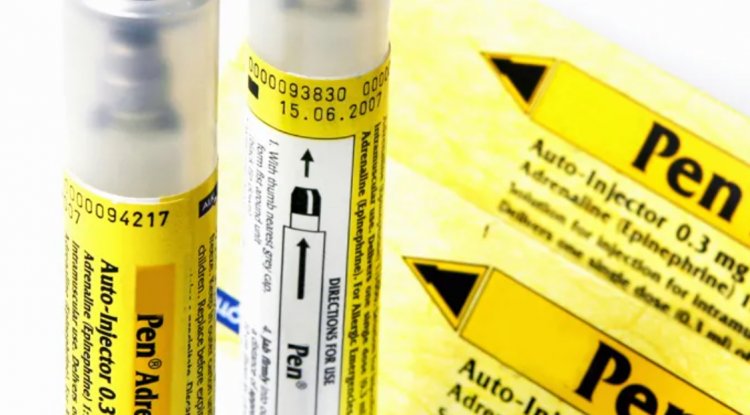Anaphylactic Shock: The Silent Storm Within
Anaphylactic shock, often referred to simply as anaphylaxis, is a severe and potentially life-threatening allergic reaction that can occur rapidly after exposure to an allergen. This condition demands immediate medical attention and intervention to prevent fatal outcomes. Despite its critical nature, many people are unaware of the causes, symptoms, and proper management of anaphylactic shock, making education on this topic crucial.
The Mechanism of Anaphylaxis
Anaphylactic shock is the result of the immune system's overreaction to a substance that is typically harmless to most people. This reaction involves a complex interplay of immune cells, antibodies, and chemicals that lead to widespread inflammation and a cascade of symptoms.
When an allergen enters the body, it triggers the release of Immunoglobulin E (IgE) antibodies. These antibodies bind to mast cells and basophils, two types of white blood cells, causing them to release histamines and other chemicals. These substances are responsible for the symptoms of anaphylaxis, such as vasodilation (widening of blood vessels), increased vascular permeability (leakage of fluid from blood vessels), and bronchoconstriction (narrowing of the airways).
Common Triggers
Various allergens can trigger anaphylactic shock. Some of the most common include:
1. Foods
- Peanuts and Tree Nuts: These are among the most frequent triggers of anaphylaxis, especially in children.
- Shellfish and Fish: Another common cause of severe allergic reactions.
- Dairy Products: Milk and its derivatives can provoke anaphylactic reactions in sensitive individuals.
- Eggs: Egg proteins are a common allergen, particularly in children.
- Other Foods: Soy, wheat, and certain fruits can also cause anaphylaxis.
2. Medications
- Antibiotics: Penicillin and related antibiotics are notorious for causing severe allergic reactions.
- Nonsteroidal Anti-Inflammatory Drugs (NSAIDs): Aspirin, ibuprofen, and other NSAIDs can trigger anaphylaxis.
- Anesthesia: Certain anesthetic agents can provoke severe allergic responses.
- Vaccines: While rare, some vaccines can cause anaphylactic reactions in susceptible individuals.
3. Insect Stings
- Bees and Wasps: Stings from these insects are common triggers of anaphylaxis.
- Fire Ants: Bites from fire ants can also cause severe allergic reactions.
4. Latex
- Products made from natural rubber latex can cause anaphylactic reactions in sensitive individuals.
5. Exercise-Induced Anaphylaxis
- A rare form where physical activity triggers a severe allergic response, sometimes in combination with specific foods or medications.
Recognizing the Symptoms
Anaphylaxis symptoms typically appear within minutes to an hour after exposure to the allergen. Recognizing these symptoms early is vital for prompt treatment. Common symptoms include:
1. Skin Reactions
- Hives: Raised, red, itchy welts on the skin.
- Flushing: Redness of the skin.
- Swelling: Particularly around the eyes, lips, and throat.
2. Respiratory Symptoms
- Difficulty Breathing: Caused by swelling of the airways and bronchoconstriction.
- Wheezing: A high-pitched whistling sound while breathing.
- Coughing: Persistent and severe cough.
3. Cardiovascular Symptoms
- Low Blood Pressure: Caused by vasodilation and fluid leakage from blood vessels.
- Rapid or Weak Pulse: The heart struggles to maintain blood pressure.
- Dizziness or Fainting: Due to decreased blood flow to the brain.
4. Gastrointestinal Symptoms
- Nausea and Vomiting: Common reactions during anaphylaxis.
- Diarrhea: Can also occur during severe allergic reactions.
- Abdominal Pain: Cramping and discomfort.
5. Neurological Symptoms
- Anxiety or Feeling of Impending Doom: A common but often overlooked symptom.
- Confusion: Resulting from decreased oxygen to the brain.
Immediate Response and Treatment
Prompt treatment is essential in managing anaphylactic shock. The primary treatment involves the administration of epinephrine (adrenaline), which counteracts the severe allergic reaction by:
- Constriction of Blood Vessels: Raises blood pressure.
- Relaxation of Airway Muscles: Improves breathing.
- Reduction of Swelling: Decreases the permeability of blood vessels.
Administering Epinephrine
- Epinephrine Auto-Injectors: Devices like EpiPen are designed for easy and rapid self-administration. They deliver a pre-measured dose of epinephrine into the thigh muscle.
- Dosage: For adults and children over 30 kg, a 0.3 mg dose is typical. For children between 15-30 kg, a 0.15 mg dose is recommended.
Calling Emergency Services
- After administering epinephrine, it's crucial to call emergency services immediately. Anaphylaxis can recur even after initial treatment, and further medical intervention may be necessary.
Positioning the Patient
- Lay Flat with Legs Elevated: This position helps maintain blood flow to vital organs.
- Avoid Standing or Sitting Up Suddenly: To prevent a sudden drop in blood pressure.
Administering Additional Medications
- Antihistamines and Corticosteroids: These medications can help manage symptoms and prevent delayed reactions but should not replace epinephrine as the primary treatment.
Monitoring and Support
- Vital Signs: Continuous monitoring of the patient's breathing, pulse, and blood pressure is critical.
- Oxygen: Supplemental oxygen may be necessary for patients with severe respiratory distress.
Long-Term Management and Prevention
Managing anaphylaxis extends beyond the immediate response to an allergic reaction. It involves comprehensive strategies to prevent future episodes and educate patients and their families about managing their allergies effectively.
1. Identification of Allergens
- Allergy Testing: Skin prick tests and blood tests can help identify specific allergens.
- Detailed History: A thorough history of the patient's allergic reactions can provide valuable clues.
2. Avoidance Strategies
- Food Allergens: Reading food labels, avoiding cross-contamination in kitchens, and informing restaurants about food allergies are crucial steps.
- Medications: Patients should inform healthcare providers about their allergies to avoid exposure to triggering medications.
- Insect Stings: Wearing protective clothing, using insect repellents, and avoiding known insect habitats can reduce the risk of stings.
- Latex: Using non-latex gloves and avoiding products containing latex can prevent reactions.
3. Anaphylaxis Action Plan
Developing a personalized anaphylaxis action plan is essential. This plan should include:
- Recognizing Symptoms: Education on early signs of anaphylaxis.
- Epinephrine Administration: Instructions on how to use epinephrine auto-injectors.
- Emergency Contacts: A list of emergency phone numbers, including healthcare providers.
- Follow-Up Care: Guidance on seeking medical attention after an episode.
4. Education and Training
- Patients and Families: Comprehensive education on managing allergies, using epinephrine auto-injectors, and recognizing symptoms.
- Schools and Workplaces: Training staff on allergy management and emergency response procedures.
- Healthcare Providers: Ensuring that all medical personnel are knowledgeable about anaphylaxis and its treatment.
5. Medic Alert Identification
- Bracelets and Necklaces: Wearing medical alert jewelry that indicates allergies can inform emergency responders during an anaphylactic episode.
6. Regular Medical Follow-Up
Regular check-ups with an allergist or immunologist can help manage and monitor allergies. These visits provide opportunities to:
- Review and Update Action Plans: Ensure that the patient's action plan is current and effective.
- Evaluate New Symptoms: Address any new or worsening symptoms.
- Discuss New Treatments: Explore emerging treatments and preventive measures.
Emerging Treatments and Research
While epinephrine remains the cornerstone of anaphylaxis treatment, ongoing research is exploring new therapies and strategies to improve management and prevention.
1. Biologic Therapies
- Monoclonal Antibodies: Medications like omalizumab (Xolair) target IgE antibodies, potentially reducing the severity of allergic reactions.
2. Oral Immunotherapy
- Desensitization: Gradual exposure to increasing amounts of an allergen under medical supervision to build tolerance.
3. Novel Epinephrine Delivery Systems
- Alternative Administration Routes: Research into nasal sprays and sublingual tablets aims to provide easier and faster administration of epinephrine.
4. Genetic Research
- Understanding Genetic Predisposition: Identifying genetic factors that contribute to severe allergies may lead to personalized treatments.
5. Improved Auto-Injectors
- User-Friendly Designs: New auto-injector designs focus on ease of use and accessibility.
Psychological Impact and Support
Anaphylaxis not only affects physical health but also has significant psychological impacts. Fear of future reactions can lead to anxiety and reduced quality of life.
1. Counseling and Support Groups
- Emotional Support: Counseling can help patients and families cope with anxiety related to severe allergies.
- Peer Support: Connecting with others who have similar experiences can provide valuable support and advice.
2. Addressing Anxiety
- Cognitive Behavioral Therapy (CBT): CBT can help manage anxiety by changing negative thought patterns and behaviors.
- Mindfulness and Relaxation Techniques: These can reduce stress and improve overall well-being.
3. Building Confidence
- Education and Preparedness: Knowledge and preparedness can empower patients and reduce fear.
- Practice Drills: Regular practice of action plans can build confidence in managing allergic reactions.
Anaphylaxis in Special Populations
Certain populations may face unique challenges in managing anaphylaxis. Tailored approaches are necessary to address these challenges effectively.
1. Children
- School Policies: Schools should have policies in place for managing food allergies and anaphylaxis.
- Education Programs: Teaching children about their allergies and how to avoid triggers.
- Parental Involvement: Parents should work closely with schools and caregivers to ensure safety.
2. Elderly
- Polypharmacy: Older adults often take multiple medications, increasing the risk of allergic reactions.
- Comorbidities: Pre-existing health conditions can complicate the management of anaphylaxis.
3. Pregnant Women
- Medication Safety: Ensuring that treatments for anaphylaxis are safe for both the mother and the fetus.
- Monitoring: Close monitoring of both maternal and fetal health during an anaphylactic episode.
Overall Conclusive Paragraph
Anaphylactic shock is a critical medical emergency that requires swift recognition and immediate treatment. Understanding the mechanisms, triggers, and symptoms of anaphylaxis can save lives. Equally important is the implementation of long-term management strategies, including allergen avoidance, education, and personalized action plans. Advances in research hold promise for improved treatments and preventive measures. Through comprehensive care and support, individuals with severe allergies can lead safer, healthier lives, free from the constant fear of anaphylactic reactions.
Disclaimer
The information provided in this article is for educational purposes only and should not be considered medical advice. If you have any health concerns or are experiencing symptoms, it is important to consult with a healthcare professional, such as a doctor or clinic, for proper diagnosis and treatment. Always seek the advice of your doctor or other qualified health provider with any questions you may have regarding a medical condition. Do not disregard professional medical advice or delay in seeking it because of something you have read in this article.
What's Your Reaction?
























